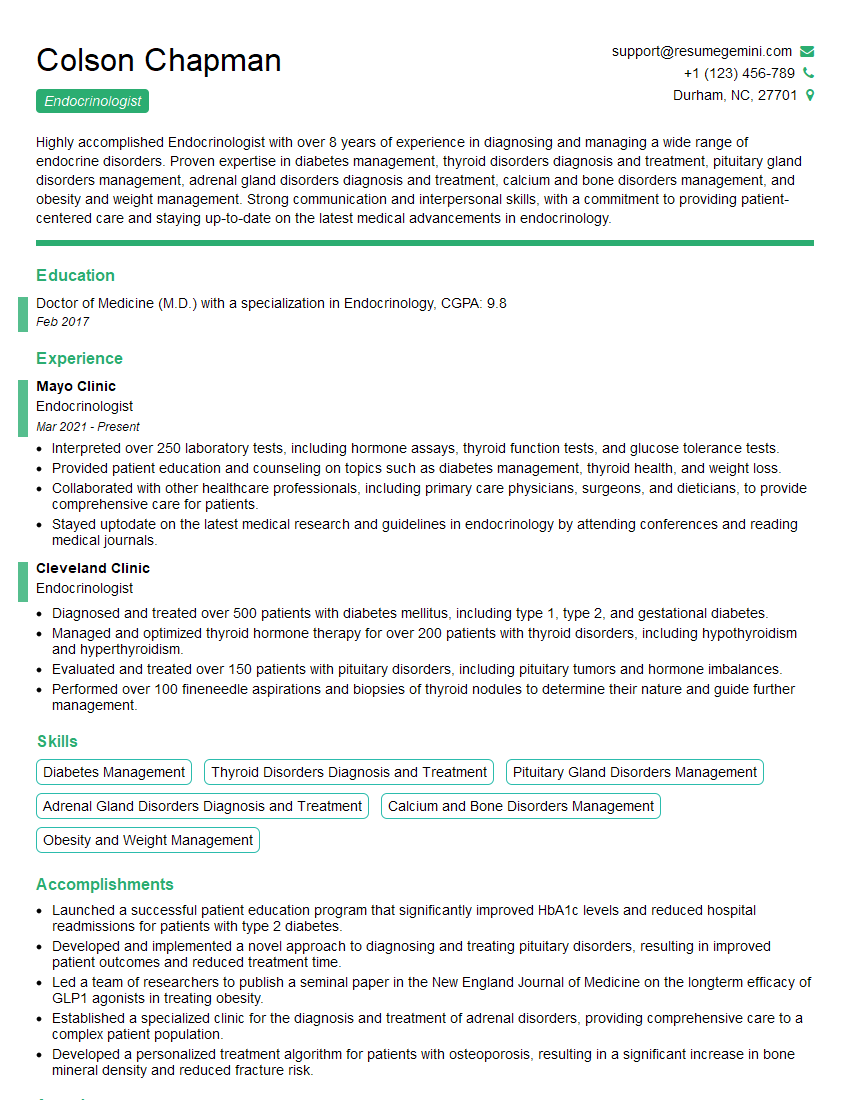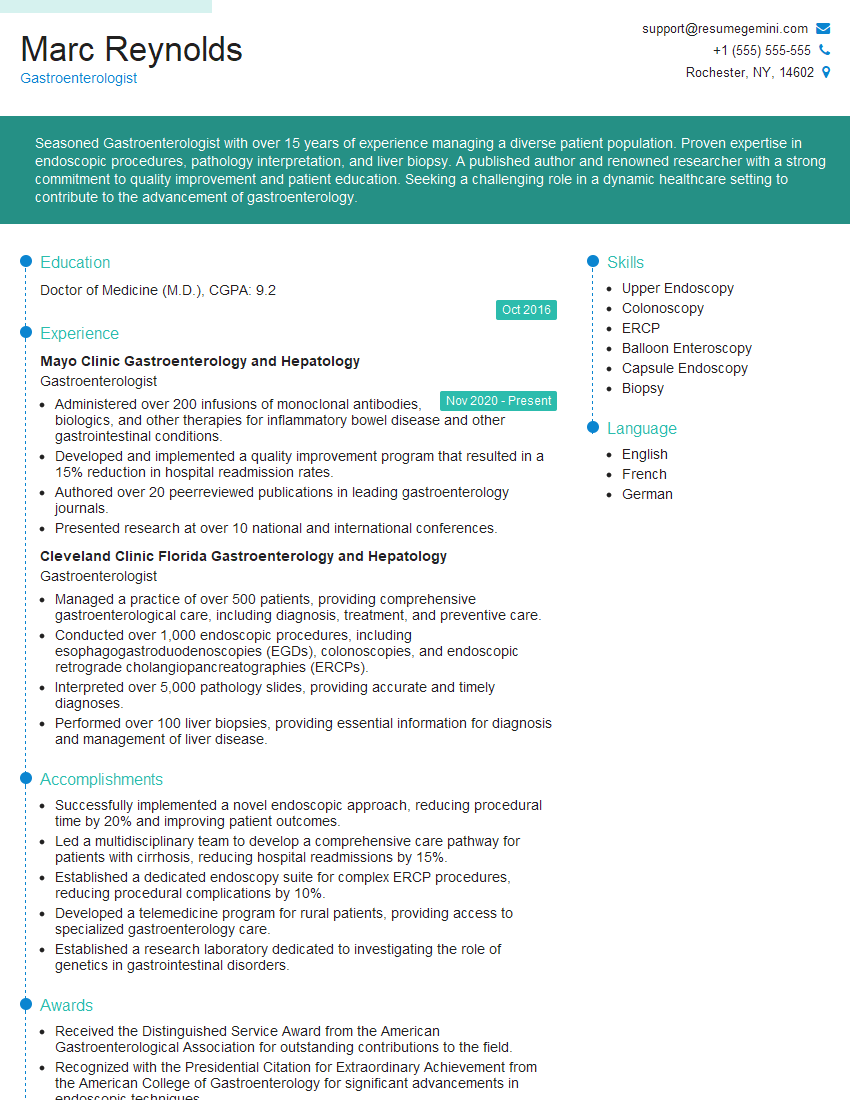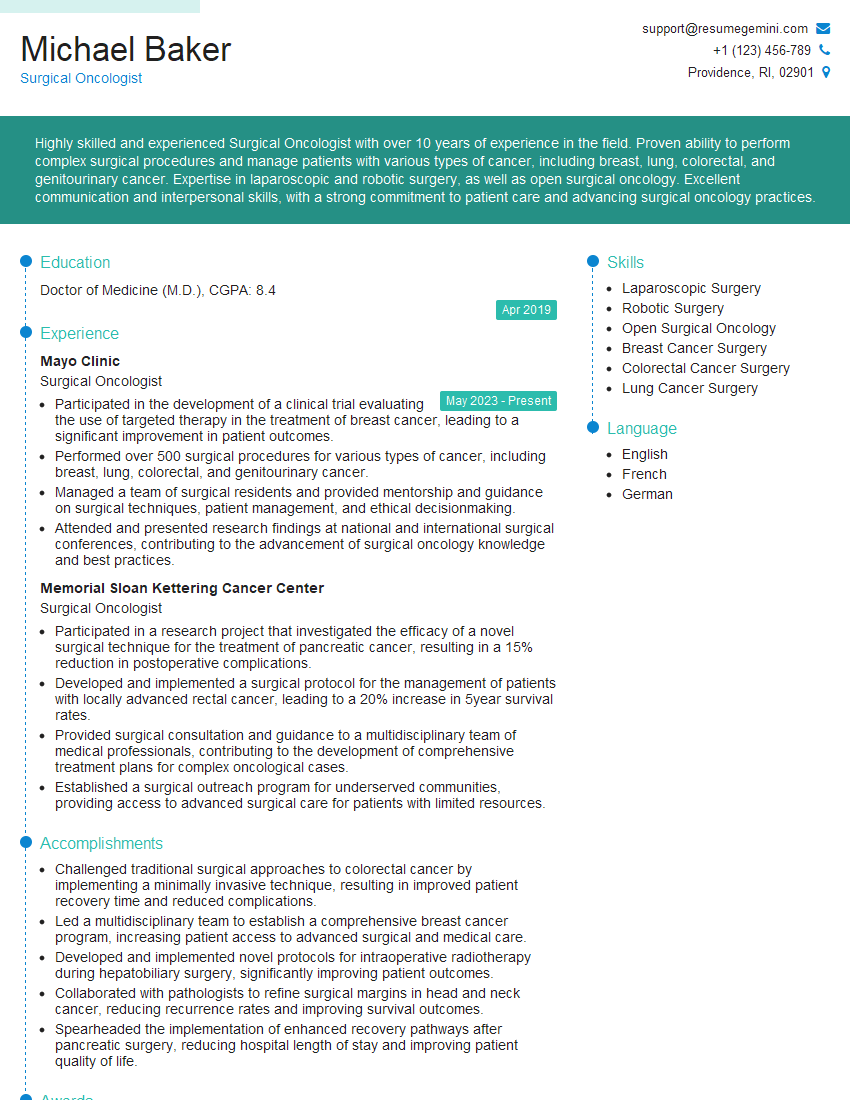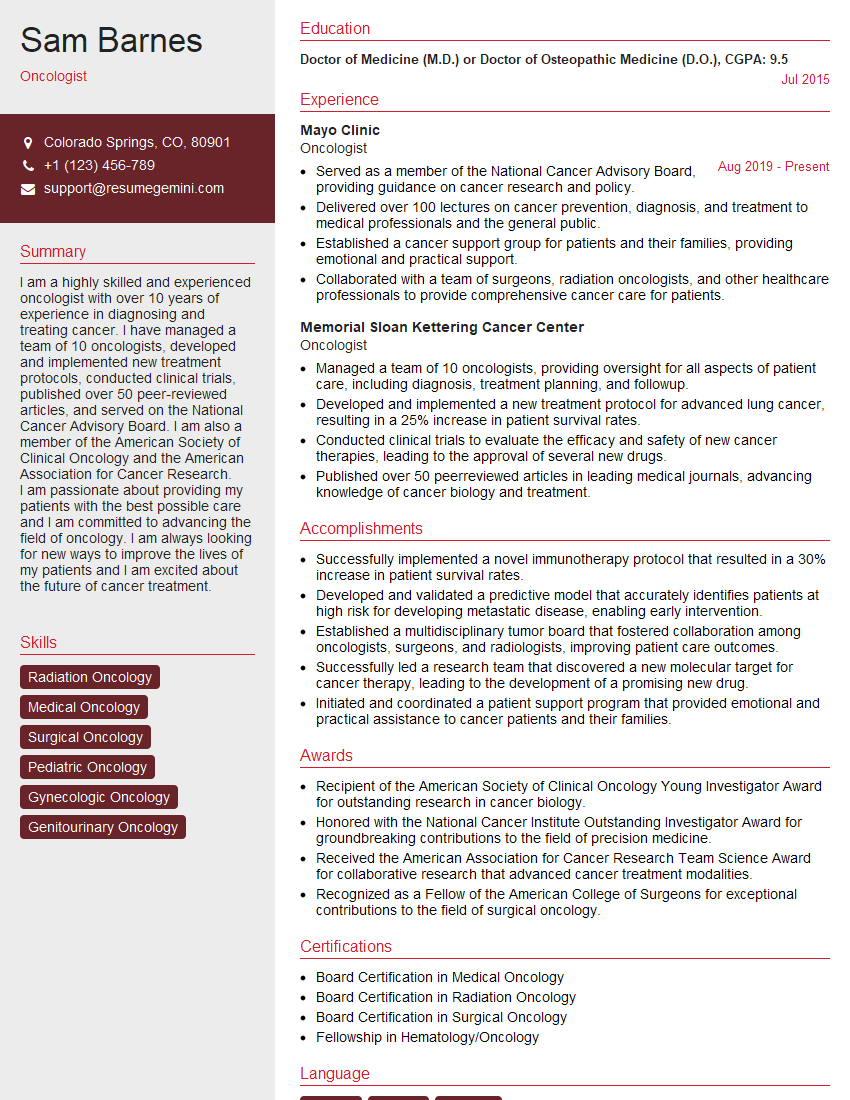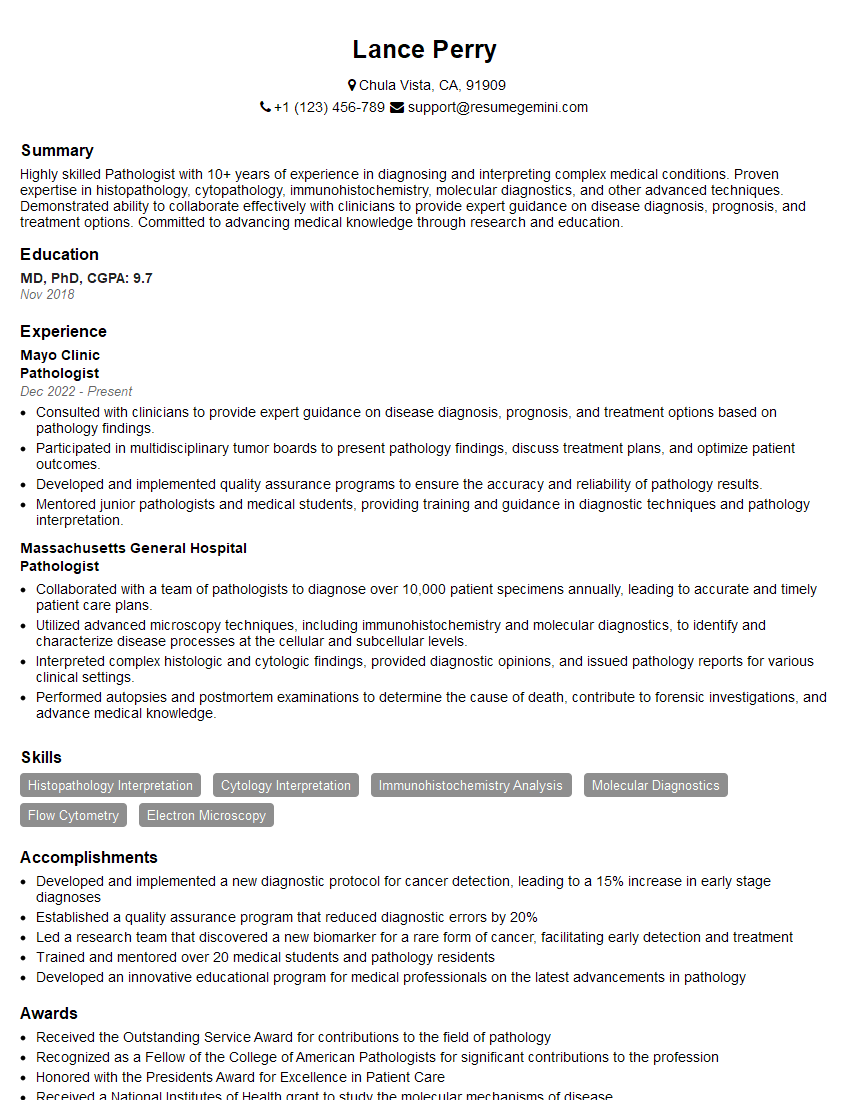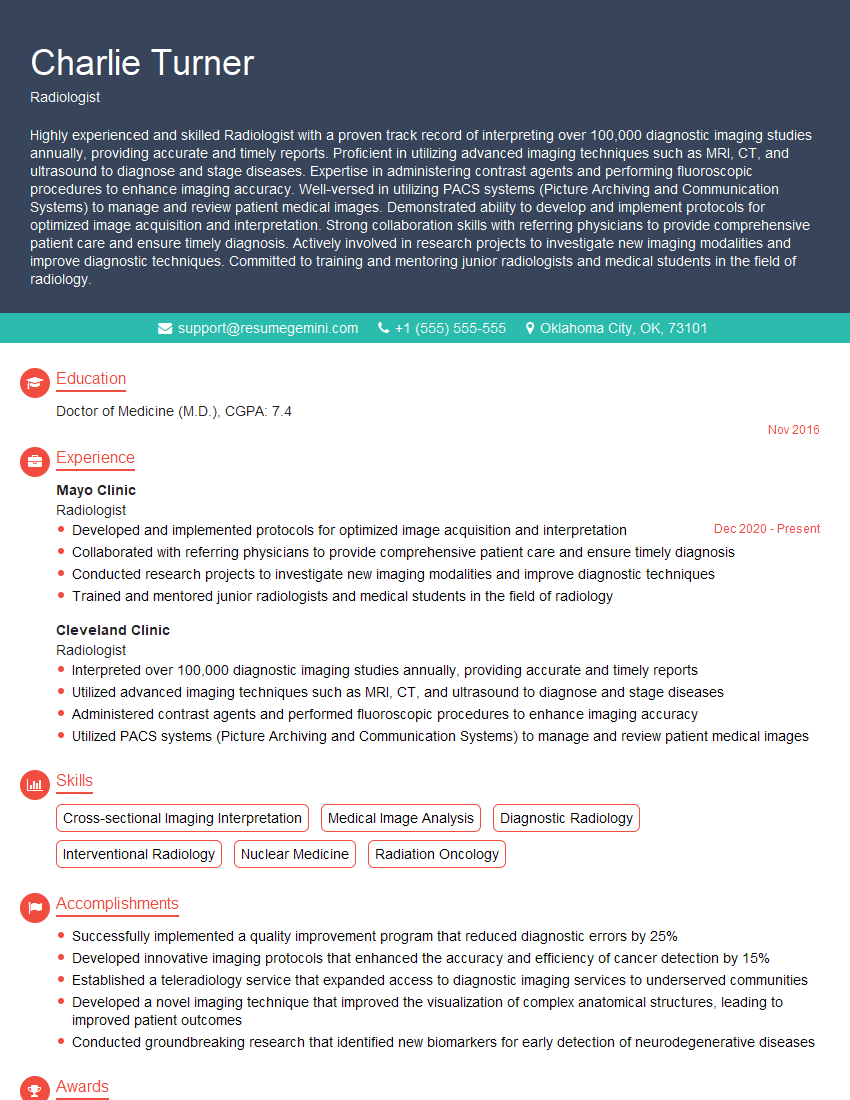Cracking a skill-specific interview, like one for Pancreatic Cancer, requires understanding the nuances of the role. In this blog, we present the questions you’re most likely to encounter, along with insights into how to answer them effectively. Let’s ensure you’re ready to make a strong impression.
Questions Asked in Pancreatic Cancer Interview
Q 1. Describe the staging systems used for pancreatic cancer.
Pancreatic cancer staging uses systems like the American Joint Committee on Cancer (AJCC) TNM system, which categorizes the tumor’s size (T), lymph node involvement (N), and distant metastasis (M). A higher stage indicates more advanced disease. For instance, a T1N0M0 tumor is small, hasn’t spread to lymph nodes, and hasn’t metastasized, while a T4N1M1 tumor is large, involves lymph nodes, and has spread to distant sites. This system helps doctors determine the best treatment approach and prognosis. Another important aspect is the tumor’s resectability, whether it’s surgically removable. This often influences treatment decisions more than the TNM stage alone. Think of it like a map guiding treatment; the higher the stage, the more extensive and complex the treatment path generally becomes.
- T (Tumor): Describes the size and extent of the primary tumor.
- N (Nodes): Indicates the presence and extent of lymph node involvement.
- M (Metastasis): Describes the presence of distant metastases (spread to other organs).
Q 2. Explain the differences between pancreatic adenocarcinoma and other pancreatic cancers.
Pancreatic adenocarcinoma is the most common type of pancreatic cancer, accounting for over 90% of cases. It originates in the exocrine glands of the pancreas, responsible for producing digestive enzymes. Other, less frequent types include pancreatic neuroendocrine tumors (PanNETs), which arise from hormone-producing cells, and intraductal papillary mucinous neoplasms (IPMNs), which are precancerous lesions that can sometimes progress to adenocarcinoma. The key difference lies in their origin (exocrine vs. endocrine cells) and the resulting clinical presentation and treatment approach. PanNETs, for instance, often have different hormonal symptoms, and IPMNs require close monitoring and sometimes surgery depending on characteristics.
Imagine the pancreas as a factory. Adenocarcinoma is like a major malfunction in the production line of digestive enzymes, while PanNETs are like problems in the hormone production section. Each needs a different type of repair.
Q 3. What are the key risk factors associated with pancreatic cancer?
Several risk factors increase the likelihood of developing pancreatic cancer. Smoking is the most significant, substantially increasing the risk. Family history of pancreatic cancer or other genetic conditions like BRCA mutations also elevate the risk. Chronic pancreatitis (inflammation of the pancreas), diabetes, obesity, and older age are other established risk factors. Dietary factors like a diet low in fruits and vegetables are also suspected but require more research to solidify their link. It’s crucial to understand that having these risk factors doesn’t guarantee you’ll develop pancreatic cancer, but they increase your chances.
Think of it like a car engine; several factors can damage it, and each adds to the likelihood of failure. Smoking is a major hit, while genetics, chronic pancreatitis and obesity add more stress to the system.
Q 4. Discuss the various diagnostic imaging techniques used in pancreatic cancer detection.
Diagnosing pancreatic cancer often involves several imaging techniques. CT scans (computed tomography) provide detailed cross-sectional images of the abdomen, helping visualize the tumor’s size, location, and spread. MRI (magnetic resonance imaging) offers superior soft tissue contrast, beneficial for assessing the tumor’s relationship to surrounding blood vessels. Endoscopic ultrasound (EUS) allows for high-resolution imaging of the pancreas, often guided by a needle biopsy for tissue sampling. ERCP (endoscopic retrograde cholangiopancreatography) can assess bile and pancreatic ductal systems. Each technique offers unique advantages, often used in combination for a comprehensive diagnosis. Sometimes PET scans are utilized to check for distant metastasis.
Imagine a mechanic diagnosing a car issue. They might use various tools – a visual inspection, a computer diagnostic scan, and other specialized tools – to pinpoint the problem’s location and extent. Similarly, doctors utilize multiple imaging techniques for a precise diagnosis of pancreatic cancer.
Q 5. Outline the current treatment options for pancreatic cancer, including surgery, chemotherapy, radiation, and targeted therapy.
Treatment options for pancreatic cancer vary greatly depending on the stage and overall health of the patient. Surgery, if possible (resectable), is the primary treatment for localized disease, aiming to completely remove the tumor and nearby lymph nodes. Chemotherapy uses drugs to kill cancer cells, often administered systemically (throughout the body). Radiation therapy uses high-energy radiation to damage cancer cells. Targeted therapy utilizes drugs that specifically target cancer cells, minimizing harm to healthy cells. These modalities are often combined in various sequences and intensities to achieve the best outcomes. For instance, a patient might receive chemotherapy and radiation before surgery (neoadjuvant) and then chemotherapy after surgery (adjuvant). For advanced, unresectable disease, palliative approaches focusing on symptom relief and improving quality of life might be prioritized.
Q 6. Explain the role of neoadjuvant and adjuvant therapy in pancreatic cancer treatment.
Neoadjuvant therapy refers to treatment given before surgery. This can shrink the tumor, making it easier to surgically remove and potentially improving the chances of a complete resection. Adjuvant therapy, on the other hand, is given after surgery to eliminate any remaining microscopic cancer cells and prevent recurrence. Both strategies aim to improve outcomes and survival rates. Imagine neoadjuvant therapy as pre-surgery preparation, making the operation easier and more effective, and adjuvant therapy as post-surgery insurance, reducing the risk of future problems. The specific regimen depends on multiple factors, like tumor stage, location, and the patient’s overall health.
Q 7. What are the common side effects of chemotherapy and radiation therapy for pancreatic cancer?
Chemotherapy and radiation therapy, while effective, can cause various side effects. Common chemotherapy side effects include nausea, vomiting, fatigue, hair loss, mouth sores, and decreased blood cell counts (leading to increased infection risk). Radiation therapy can cause skin irritation, fatigue, diarrhea, and in some cases, damage to nearby organs depending on the treatment area. These side effects vary in severity and often are managed with supportive care, including medication and dietary adjustments. It’s crucial to remember that while the side effects can be challenging, doctors and support teams work closely with patients to manage them effectively. This is another aspect where personalization of treatment plans is paramount.
Think of it like a battle against the cancer; there will be collateral damage. The goal is to minimize the side effects while maximizing the effectiveness of the treatment. Modern medicine has several ways to alleviate these side effects and make the treatment manageable.
Q 8. How do you manage pain and other symptoms in patients with advanced pancreatic cancer?
Pain management in advanced pancreatic cancer is a crucial aspect of palliative care. It’s a multifaceted approach tailored to each patient’s unique experience. We start by assessing the pain’s location, intensity, and character using validated scales like the numerical rating scale (NRS) or the visual analog scale (VAS). The initial approach often involves analgesics, starting with non-opioids like acetaminophen or NSAIDs (non-steroidal anti-inflammatory drugs) for mild to moderate pain. As the disease progresses, we often need to transition to opioids, like morphine or oxycodone, for more severe pain, carefully titrating the dose to achieve adequate pain relief while minimizing side effects. Adjuvant medications, such as antidepressants for neuropathic pain or antiemetics for nausea and vomiting, are frequently added to optimize symptom control. For instance, a patient might initially be managed with acetaminophen and ibuprofen, but if pain worsens despite this, we would introduce low-dose oxycodone, gradually increasing the dose as needed under careful monitoring. Other strategies include nerve blocks, radiation therapy for pain relief, and even surgery in selected cases where specific nerve compression is identified.
Q 9. Describe the role of palliative care in pancreatic cancer management.
Palliative care plays a vital role in pancreatic cancer management, focusing on improving the quality of life for patients and their families. It’s not about giving up on treatment; rather, it’s about managing symptoms and supporting the patient holistically throughout the disease trajectory. In pancreatic cancer, palliative care addresses common symptoms like pain, nausea, jaundice, fatigue, and appetite loss. It involves a multidisciplinary team, including oncologists, nurses, social workers, chaplains, and physical therapists. The team works collaboratively to develop a comprehensive care plan that addresses physical, emotional, and spiritual needs. For example, a patient experiencing significant jaundice might benefit from phototherapy to reduce the discoloration and associated itching. A social worker can assist the family with financial concerns, and a chaplain can provide spiritual support. Palliative care is frequently integrated with curative or life-prolonging treatments, ensuring the patient receives both active treatment and supportive care concurrently.
Q 10. What are the latest advancements in pancreatic cancer research?
The field of pancreatic cancer research is rapidly evolving. Several promising avenues are currently being explored. Targeted therapies are showing significant promise, particularly in patients with specific genetic mutations. Immunotherapy, harnessing the body’s own immune system to fight cancer cells, is another active area of research. Early clinical trial data demonstrates some successes in improving patient outcomes, although more research is needed to establish long-term benefits and identify appropriate patient populations. Advances in surgical techniques, including minimally invasive approaches and robotic surgery, are striving to improve resection rates and reduce complications. In addition, there are significant research efforts focusing on early detection strategies, including developing more sensitive biomarkers to identify pancreatic cancer at an earlier, more treatable stage. Finally, ongoing research into the tumor microenvironment aims to understand how the tumor interacts with surrounding tissues, potentially leading to novel therapeutic targets.
Q 11. Explain the importance of genetic testing in pancreatic cancer.
Genetic testing in pancreatic cancer is becoming increasingly important. It can identify specific genetic mutations that may predict the prognosis, guide treatment decisions, and even have implications for family members. For example, identifying a germline mutation in genes like BRCA1/2, CDKN2A, or ATM can indicate a higher risk for other cancers and inform choices about prophylactic surgeries or increased surveillance. These genetic alterations may also influence treatment response to specific targeted therapies. For instance, if a patient’s tumor has a specific mutation, they might be eligible for a targeted therapy drug designed to inhibit that mutation’s activity. Furthermore, understanding the tumor’s genetic makeup can help us predict its likelihood of recurrence and guide post-surgical adjuvant treatment strategies. Therefore, genetic testing is a valuable tool in the personalized approach to managing pancreatic cancer.
Q 12. Describe your experience with Whipple procedure.
The Whipple procedure, also known as a pancreaticoduodenectomy, is a complex surgical operation to remove the head of the pancreas, the duodenum (the first part of the small intestine), part of the common bile duct, and sometimes parts of the stomach and lymph nodes. I’ve been involved in numerous Whipple procedures throughout my career, and it’s a procedure requiring meticulous planning and execution. The success of the procedure depends on several factors including the patient’s overall health, the extent of tumor involvement, and the surgeon’s experience. Post-operative care is equally critical, often involving intensive monitoring for potential complications such as pancreatic fistula, bleeding, or infection. Pre-operative assessment carefully assesses the patient’s fitness for surgery and outlines expectations regarding recovery and potential long-term consequences. I’ve found that a comprehensive team approach, involving surgeons, gastroenterologists, oncologists, and support staff, is essential for optimal patient outcomes.
Q 13. How do you assess the resectability of a pancreatic tumor?
Assessing the resectability of a pancreatic tumor is a crucial step in determining treatment options. This involves a multi-modal approach using advanced imaging techniques, such as CT scans with contrast, MRI, and endoscopic ultrasound (EUS). These scans allow us to visualize the tumor’s size, location, and its relationship to surrounding blood vessels and organs. The goal is to determine whether the tumor can be completely removed without compromising vital structures. A tumor is considered resectable if it’s confined to the pancreas without significant involvement of major blood vessels or other organs. If the tumor involves major blood vessels or has metastasized to other parts of the body, it’s deemed unresectable, and other treatment options, like chemotherapy or radiation therapy, are considered. EUS plays a particularly important role, as it can provide high-resolution images and guide biopsies for tissue sampling, crucial for confirming the diagnosis and evaluating tumor characteristics.
Q 14. Discuss the challenges in treating pancreatic cancer.
Pancreatic cancer presents several significant challenges in treatment. Its deep location within the abdomen makes early detection difficult, and by the time symptoms appear, the cancer is often advanced. The tumor’s proximity to vital blood vessels and other organs makes surgical resection challenging and potentially risky. The dense stroma surrounding the tumor hinders the penetration of chemotherapeutic agents, making systemic therapy less effective. Furthermore, pancreatic cancer cells are often highly resistant to conventional treatments, and recurrence rates are high even after seemingly successful surgery and adjuvant therapy. Finally, the significant side effects associated with many treatments can impact the patient’s quality of life. Addressing these challenges requires a multi-pronged approach involving research into novel therapeutic agents, advanced imaging techniques for early detection, improvements in surgical techniques, and a focus on individualized and supportive care to enhance patients’ well-being.
Q 15. Explain the difference between curative and palliative intent in pancreatic cancer surgery.
The difference between curative and palliative intent in pancreatic cancer surgery hinges on the goal of the intervention. Curative intent surgery aims to completely remove the cancer, offering the patient the chance for a long-term, potentially cancer-free survival. This usually involves a Whipple procedure (pancreaticoduodenectomy) or distal pancreatectomy, aiming for R0 resection – meaning complete removal of the tumor with clear margins. Success depends on several factors, including the stage of cancer, its location, and the patient’s overall health.
Conversely, palliative intent surgery focuses on improving the patient’s quality of life and managing symptoms rather than achieving a cure. This might involve procedures like biliary stenting to relieve jaundice or a gastroenterostomy to address bowel obstruction. These interventions don’t remove the tumor but help alleviate debilitating symptoms, improving comfort and extending lifespan, albeit not in a cancer-free state. The decision of curative versus palliative is made on a case-by-case basis, taking into account the patient’s individual circumstances, tumor characteristics, and a multidisciplinary team discussion.
Career Expert Tips:
- Ace those interviews! Prepare effectively by reviewing the Top 50 Most Common Interview Questions on ResumeGemini.
- Navigate your job search with confidence! Explore a wide range of Career Tips on ResumeGemini. Learn about common challenges and recommendations to overcome them.
- Craft the perfect resume! Master the Art of Resume Writing with ResumeGemini’s guide. Showcase your unique qualifications and achievements effectively.
- Don’t miss out on holiday savings! Build your dream resume with ResumeGemini’s ATS optimized templates.
Q 16. What are the prognostic factors for pancreatic cancer?
Prognostic factors in pancreatic cancer are characteristics that influence the likely outcome of the disease. These factors are crucial in determining treatment plans and predicting survival. Key prognostic factors include:
- Stage at diagnosis: Early-stage cancers (I and II) generally have a better prognosis than advanced stages (III and IV).
- Tumor grade: Higher-grade tumors (poorly differentiated) are associated with faster growth and poorer prognosis.
- Lymphovascular invasion: The presence of cancer cells in blood or lymph vessels indicates a higher risk of spread and poorer prognosis.
- Surgical resection margins: Achieving an R0 resection (complete tumor removal with clear margins) is strongly associated with better outcomes. An R1 resection (microscopic residual cancer) carries a worse prognosis.
- Performance status (PS): A patient’s overall physical capacity significantly impacts their ability to tolerate treatment and their overall survival. A higher PS (worse functional capacity) indicates a poorer prognosis.
- Age and comorbidities: Older age and the presence of other serious medical conditions can influence treatment tolerance and prognosis.
- Genetic mutations: Specific genetic alterations, such as KRAS mutations, are associated with poorer outcomes and treatment response.
It’s crucial to understand that these factors interact, and a combination of favorable and unfavorable factors will ultimately shape an individual’s prognosis. Predicting survival is inherently complex and relies on integrating all available clinical information.
Q 17. How do you counsel patients and their families about pancreatic cancer diagnosis and treatment?
Counseling patients and families facing a pancreatic cancer diagnosis is a delicate and crucial aspect of care. I start by conveying the diagnosis in a clear, compassionate manner, using language that’s easily understandable. I explain the disease in detail, including its implications and prognosis, but always emphasizing hope and tailoring the information to the patient’s comprehension. I encourage questions and address concerns honestly and openly. It’s vital to acknowledge the emotional impact of this diagnosis on both the patient and their family, allowing space for them to express their feelings.
The discussion about treatment options must include a clear explanation of the benefits, risks, and limitations of each approach. I present the evidence-based options while being mindful of the patient’s preferences and values. Involving the family in these discussions is essential, as they play a vital role in supporting the patient. I provide access to support resources, including psychosocial oncology services, support groups, and palliative care, to help patients and their families cope with the challenges of the disease and its treatment.
Throughout the process, I strive to maintain open communication, regularly updating the patient and family on their progress and any changes in their condition. My goal is to empower the patient and family to participate actively in decision-making, ensuring that treatment aligns with their preferences and goals. This collaborative approach is essential in providing the best possible care and maximizing the patient’s quality of life.
Q 18. What are the ethical considerations in treating patients with pancreatic cancer?
Ethical considerations in treating pancreatic cancer are numerous and complex, often requiring careful consideration of competing values. Key ethical issues include:
- Informed consent: Ensuring patients have a thorough understanding of the disease, treatment options, risks, and benefits before making any decisions.
- Balancing benefits and burdens of treatment: Weighing the potential benefits of aggressive treatments against the significant side effects and burdens they might impose, particularly in advanced disease.
- Resource allocation: Addressing the ethical challenges related to the allocation of scarce resources, especially given the high cost of some pancreatic cancer treatments.
- End-of-life care: Providing compassionate and comprehensive palliative care, respecting the patient’s wishes concerning life-sustaining treatment.
- Truth-telling and disclosure: Maintaining honesty and transparency while providing sensitive and empathetic communication regarding prognosis and treatment options.
- Research participation: Ensuring that patients are fully informed about the risks and benefits of participating in clinical trials and that their participation is voluntary.
Ethical decision-making in pancreatic cancer often involves a multidisciplinary team approach, including physicians, nurses, social workers, and ethicists. Open dialogue and shared decision-making between the healthcare team, the patient, and their family are critical to navigating these complex ethical considerations.
Q 19. Describe your experience with managing treatment-related complications.
Managing treatment-related complications in pancreatic cancer is a significant aspect of patient care. These complications can arise from the disease itself, the surgery, or the systemic therapies (chemotherapy, radiation, targeted therapies). Common complications include:
- Pancreatic fistula: Leakage of pancreatic fluids from the surgical site, requiring careful management with drainage and nutritional support.
- Infection: Risk of infection is high, especially post-surgery, and needs prompt antibiotic treatment.
- Gastrointestinal complications: Nausea, vomiting, diarrhea, and bowel obstruction are frequent issues, often managed with medications and dietary adjustments.
- Diabetes: Pancreatic surgery or damage from the cancer can lead to diabetes, requiring careful monitoring and management.
- Malnutrition: Cancer and treatment can cause significant weight loss, necessitating nutritional support, including enteral or parenteral nutrition.
- Toxicity from systemic therapies: Chemotherapy and radiation can cause a range of side effects, from fatigue and nausea to neutropenia (low white blood cell count), requiring close monitoring and supportive care.
My approach involves proactive monitoring for potential complications, prompt intervention when complications arise, and a multidisciplinary approach, involving surgeons, gastroenterologists, oncologists, dieticians, and nurses, to ensure comprehensive management.
Q 20. How do you stay updated on the latest advancements in pancreatic cancer treatment?
Staying current with advancements in pancreatic cancer treatment is paramount. I utilize several strategies:
- Regular review of peer-reviewed medical journals: I actively read journals like the Journal of Clinical Oncology, Annals of Oncology, and Gastroenterology to stay informed about the latest research findings.
- Attendance at medical conferences and meetings: Participating in national and international conferences allows direct interaction with leading experts and access to cutting-edge research presentations.
- Participation in professional organizations: Membership in organizations like the American Society of Clinical Oncology (ASCO) and the American Gastroenterological Association (AGA) provides access to continuing medical education resources and updates.
- Online resources and databases: I use resources like PubMed and the National Cancer Institute’s website to search for relevant research articles and clinical trial information.
- Collaboration with colleagues: Regular interaction with colleagues in different specialties (surgery, oncology, radiology, pathology) fosters knowledge sharing and facilitates access to different perspectives on treatment approaches.
By employing these methods, I ensure that I integrate the most current evidence-based practices into my clinical decision-making, aiming to provide the best possible care for my patients.
Q 21. What is your approach to multidisciplinary care in pancreatic cancer?
My approach to multidisciplinary care in pancreatic cancer is fundamentally collaborative and patient-centered. A successful treatment plan requires expertise from several disciplines, and I believe that the best outcomes are achieved through a coordinated, team-based approach. The core team typically includes:
- Medical Oncologist: Manages systemic therapies (chemotherapy, targeted therapies).
- Surgical Oncologist: Performs surgical procedures, when appropriate.
- Radiation Oncologist: Delivers radiation therapy as part of the treatment plan.
- Gastroenterologist: Manages gastrointestinal complications and biliary drainage procedures.
- Radiologist: Provides imaging guidance for diagnosis and treatment.
- Pathologist: Analyzes tissue samples to determine the type and grade of cancer.
- Registered Dietitian: Provides nutritional counseling and support.
- Social Worker: Offers psychosocial support and resources to the patient and family.
- Palliative Care Team: Focuses on comfort and symptom management.
We meet regularly as a team to discuss each patient’s case, considering their individual needs, preferences, and the latest evidence-based guidelines. This collaborative approach ensures that every aspect of the patient’s care is addressed, optimizing their chances of success, no matter the treatment goals. Open communication is critical amongst the team members and between the team and the patient. A shared understanding of the treatment plan and the patients’ overall goals is paramount for the success of multidisciplinary care.
Q 22. Explain your understanding of clinical trials related to pancreatic cancer.
Clinical trials in pancreatic cancer are crucial for advancing treatment options. They are research studies involving patients who volunteer to test new treatments, such as novel chemotherapy regimens, targeted therapies, immunotherapies, or combinations thereof. These trials are rigorously designed to evaluate the safety and effectiveness of these interventions.
Trials are categorized into phases, each with specific objectives:
- Phase I: Primarily focuses on safety and determining the maximum tolerated dose of a new treatment.
- Phase II: Assesses the effectiveness of the treatment in a larger group of patients and further evaluates its safety.
- Phase III: Compares a new treatment to the current standard of care to determine if it’s superior. This involves a large number of patients and rigorous statistical analysis.
Participation in clinical trials offers patients access to cutting-edge treatments that may not be available otherwise. It’s important to note that not all trials are suitable for every patient, and careful consideration of the risks and benefits is essential. The decision to participate should be made in close consultation with an oncologist.
Q 23. Describe a case where you had to make a difficult decision regarding a patient with pancreatic cancer.
One particularly challenging case involved a 65-year-old patient with locally advanced pancreatic cancer. He was a vibrant individual with a strong family support system, but his tumor was inoperable due to its proximity to vital blood vessels. We faced a difficult decision regarding the most appropriate treatment approach: chemotherapy alone versus chemoradiotherapy.
Chemotherapy offered a less aggressive initial approach, potentially causing fewer side effects, while chemoradiotherapy could potentially offer better tumor control but with a higher risk of complications. After a thorough discussion with the patient and his family, weighing the potential benefits and risks of each approach, we opted for a modified chemoradiotherapy regimen tailored to minimize side effects while maximizing the chance of local control and improving his overall quality of life. We closely monitored him throughout the treatment and adjusted the plan based on his response and tolerance. Although the prognosis remained challenging, this individualized approach allowed us to optimize his care based on his specific circumstances and preferences.
Q 24. How do you communicate complex medical information to patients and families?
Communicating complex medical information to patients and families requires empathy, patience, and clear, concise language. I always begin by assessing their understanding of medical terminology and tailor my explanation accordingly, avoiding jargon as much as possible. I use analogies and visual aids, such as diagrams or pictures, to help illustrate complex concepts.
I ensure the information is delivered in a calm and supportive environment, allowing ample time for questions and clarification. I also involve family members or caregivers in the discussion, ensuring everyone understands the treatment plan, potential side effects, and prognosis. I find it helpful to use a shared decision-making approach, empowering patients to actively participate in choosing their treatment path. Written materials summarizing the discussion are also provided for reference.
Q 25. What is your experience with minimally invasive surgical techniques for pancreatic cancer?
Minimally invasive surgical techniques, such as laparoscopic or robotic surgery, have revolutionized pancreatic cancer treatment. These methods offer several advantages over traditional open surgery, including smaller incisions, reduced pain, less blood loss, shorter hospital stays, and faster recovery times.
My experience includes both assisting in and performing these procedures. The technical challenges are significant, requiring specialized training and expertise. Careful patient selection is crucial, as not all patients are suitable candidates for minimally invasive techniques. We meticulously assess the tumor’s location, size, and involvement of surrounding structures to determine the feasibility of a minimally invasive approach. While the benefits are substantial, it’s vital to ensure patient safety and the adequacy of tumor resection.
Q 26. How do you evaluate the response to treatment in pancreatic cancer?
Evaluating the response to treatment in pancreatic cancer involves a combination of imaging studies (CT scans, MRI, endoscopic ultrasound) and clinical assessments. Imaging helps to visualize the tumor’s size and changes in its appearance.
A reduction in tumor size or a stabilization of disease, as assessed by RECIST criteria (Response Evaluation Criteria in Solid Tumors) is considered a positive response. Clinical markers such as CA 19-9 levels (a tumor marker) are also monitored, though they are not always reliable indicators of treatment response. Furthermore, we assess the patient’s symptoms and overall well-being – quality of life is a key component of evaluating treatment effectiveness. A multidisciplinary approach, involving oncologists, surgeons, radiologists, and other specialists is crucial for comprehensive evaluation.
Q 27. Discuss the role of immunotherapy in pancreatic cancer treatment.
Immunotherapy holds promise in pancreatic cancer treatment, although it remains a challenging area. Unlike traditional therapies that directly target cancer cells, immunotherapy aims to harness the patient’s own immune system to fight the tumor. This involves stimulating the immune system to recognize and attack cancer cells.
Different immunotherapy approaches are being investigated, including checkpoint inhibitors (such as anti-PD-1 or anti-PD-L1 antibodies) which block proteins that prevent immune cells from attacking cancer cells. However, the response rates to immunotherapy in pancreatic cancer are relatively low compared to other cancer types, partly due to the tumor’s immunosuppressive microenvironment. Ongoing research focuses on improving immunotherapy strategies, such as combining them with other treatments (e.g., chemotherapy or radiation therapy) or targeting specific immune pathways to enhance their effectiveness.
Q 28. Explain your understanding of the molecular pathways involved in pancreatic cancer development.
Pancreatic cancer development is a complex process involving multiple molecular pathways and genetic alterations. Several key pathways are implicated, including:
- KRAS mutations: Mutations in the KRAS gene are found in the vast majority of pancreatic cancers, driving uncontrolled cell growth and proliferation.
- TP53 mutations: TP53, a tumor suppressor gene, is frequently mutated in pancreatic cancer, contributing to genomic instability and cancer progression.
- SMAD4 mutations: Inactivation of the SMAD4 gene, part of the TGF-beta signaling pathway, disrupts cellular regulation and promotes tumor growth.
- Other pathways: Other genetic and epigenetic alterations affect various signaling pathways involved in cell cycle control, apoptosis (programmed cell death), and angiogenesis (formation of new blood vessels).
Understanding these molecular pathways is essential for developing targeted therapies that specifically inhibit the abnormal signaling involved in tumor development. Ongoing research is focused on identifying additional key drivers and developing drugs to effectively target them.
Key Topics to Learn for Pancreatic Cancer Interview
- Tumor Biology and Genetics: Understanding the genetic mutations driving pancreatic cancer, including KRAS, TP53, and SMAD4, and their implications for treatment strategies.
- Diagnosis and Staging: Mastering the techniques used in diagnosing pancreatic cancer (imaging, biopsies, biomarkers) and the different staging systems (TNM) to assess disease extent.
- Treatment Modalities: Gaining a comprehensive understanding of surgical approaches (Whipple procedure, distal pancreatectomy), chemotherapy regimens (FOLFIRINOX, gemcitabine), radiation therapy, and targeted therapies (PARP inhibitors).
- Clinical Trials and Novel Therapies: Familiarize yourself with the landscape of ongoing clinical trials and emerging therapeutic approaches, including immunotherapy and oncolytic viruses.
- Patient Management and Supportive Care: Learn about managing common side effects of treatment (pain, nausea, fatigue), addressing psychosocial needs, and providing palliative care.
- Research Methods and Data Analysis: Develop a strong understanding of relevant research methodologies, including pre-clinical models and clinical trial design, and data analysis techniques.
- Ethical Considerations: Become familiar with the ethical considerations in pancreatic cancer research and treatment, such as informed consent and end-of-life care.
- Epidemiology and Risk Factors: Understand the incidence, prevalence, and risk factors associated with pancreatic cancer, including age, smoking, family history, and diabetes.
- Prognosis and Survival: Understand factors that influence prognosis and survival rates in pancreatic cancer patients and how to communicate this information effectively.
- Problem-Solving in a Clinical Setting: Practice analyzing complex clinical scenarios, formulating differential diagnoses, and developing treatment plans in collaboration with a multidisciplinary team.
Next Steps
Mastering the complexities of pancreatic cancer significantly enhances your career prospects in oncology and related fields. A strong understanding of this challenging disease demonstrates specialized knowledge and problem-solving skills highly valued by employers. To increase your chances of securing your ideal role, focus on crafting an ATS-friendly resume that showcases your expertise effectively. ResumeGemini is a trusted resource for building professional resumes that stand out. Leverage their tools and resources to build a compelling resume, and take advantage of the examples of resumes tailored to Pancreatic Cancer they provide to gain inspiration and insight into best practices.
Explore more articles
Users Rating of Our Blogs
Share Your Experience
We value your feedback! Please rate our content and share your thoughts (optional).
What Readers Say About Our Blog
These apartments are so amazing, posting them online would break the algorithm.
https://bit.ly/Lovely2BedsApartmentHudsonYards
Reach out at [email protected] and let’s get started!
Take a look at this stunning 2-bedroom apartment perfectly situated NYC’s coveted Hudson Yards!
https://bit.ly/Lovely2BedsApartmentHudsonYards
Live Rent Free!
https://bit.ly/LiveRentFREE
Interesting Article, I liked the depth of knowledge you’ve shared.
Helpful, thanks for sharing.
Hi, I represent a social media marketing agency and liked your blog
Hi, I represent an SEO company that specialises in getting you AI citations and higher rankings on Google. I’d like to offer you a 100% free SEO audit for your website. Would you be interested?
